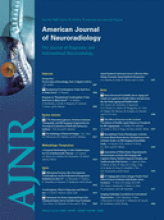Abstract
BACKGROUND AND PURPOSE: Several studies have questioned the traditional belief that the corticospinal tract (CST) arises exclusively from the precentral gyrus and passes through the anterior half of the posterior limb of the internal capsule (PLIC) in humans; however, no direct evidence existed from structural imaging, and developmental aspects of CST origin have not been clarified. We used diffusion tensor imaging (DTI) tractography to test the hypotheses that CST can originate from both pre- and postcentral gyri and is located posteriorly in the PLIC, and we also determined how age, sex, or handedness affected these locations.
MATERIALS AND METHODS: Forty-two healthy children (2.6–17.5 years of age; 20 girls) underwent DTI. Subsequently, tractography was performed on the basis of fiber assignment by continuous tracking (FACT) algorithm and brute force approach, with a fractional anisotropy (FA) threshold of <0.2 and an angle threshold of >50°. The CST was isolated by using a knowledge-based region-of-interest approach, and its cortical origin and location on the PLIC was determined.
RESULTS: DTI revealed that the CST originated from both pre- and postcentral gyri in 71.4% of hemispheres, from the precentral gyrus only in 19%, and from the postcentral gyrus only in 7.1%. The overall distribution was similar in both hemispheres. However, children with CST originating from both pre- and postcentral gyri were older (mean, 11.1 years of age) than those with precentral origin (mean, 5.8 years of age) or postcentral origin (mean, 7.8 years of age) only (P = .00003). The center of the CST was localized at 65% of the length (from its anterior margin) of the PLIC, and the CST occupied 26.5% of its anteroposterior length. There was a significant positive correlation between age and FA of the CST (r = 0.49; P = .002). The volume of the precentral portion of the left CST was significantly higher than that of its postcentral portion (P = .01) and that of the right CST (P = .0002). The pattern of cortical origin of CST, its location at the level of PLIC, and its volume and FA were unaffected by sex or handedness.
CONCLUSIONS: The CST most frequently originates from both pre- and postcentral gyri, especially in older children, and is typically centered approximately two thirds of the distance from the anterior margin of the PLIC and occupies about a quarter of its anteroposterior length. In young children, the CST can often be seen originating exclusively from the precentral gyrus by DTI.
- Copyright © American Society of Neuroradiology
Indicates open access to non-subscribers at www.ajnr.org












